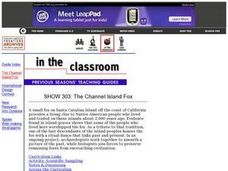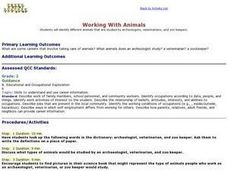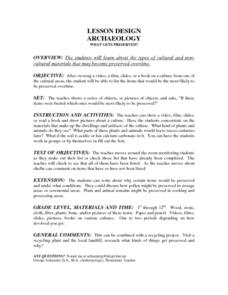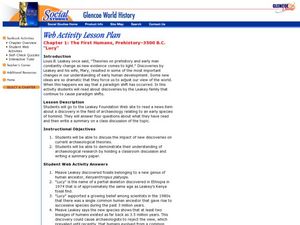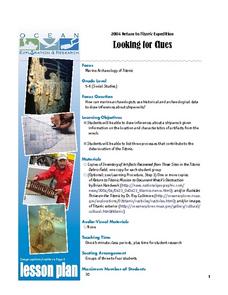Curated OER
Can You Dig It?
Students use a mock archaeological site to dig up artifacts. They read an article about artifacts found in Syria. They develop a list of artifacts that are related to specific sites in the community. They create an exhibition of these...
Ocean Explorer
Looking for Clues
Upper graders become "shipwreck detectives" by studying the debris field from a shipwreck in the Aegean Sea which took place in the 700s. A website is accessed that gives specific information about the debris field, and pairs of...
Curated OER
Replacing Missing Links in the Evolutionary Chain
Examine the evolution of various species of hominids from their earliest existence approximately 4.5 million years ago to today. In small groups, learners research one of the ten stages of hominid evolution and then create a poster and...
Channel Islands Film
Once Upon a Time (Saxipak’a): Lesson Plan 4
How did the environment and natural resources found on the Channel islands influence the culture of the Chumash? Archaeology meets technology in an activity designed for middle schoolers. After viewing West of The West's documentary Once...
Curated OER
Archaeological Finds
Students demonstrate the goals and methods of archaeology and write a report of an archaeological dig at a site associated with a specific culture. They explore the science of archaeology and how it contributes to the understanding of...
Curated OER
SHOW 303: The Channel Island Fox
Young scholars explore how archaeologists and other scientists use different clues to piece together a picture of the past. Students perform activities that allow them to conduct three types of scientific research. They discuss their...
Curated OER
Working With Animals
Second graders study careers that involve animal care such as veterinarians, zookeepers and archeologists. They create a collage of animal drawings related to the careers.
Curated OER
Predicting the Past
Students study how archaeologists record the past. They discuss archaeology and artifacts. They view a list of artifacts discovered by Marquette at the Illinois Village and answer questions regarding them. They complete a test about...
Curated OER
Digging in the Classroom
First graders "excavate" a story. In this creative earth science instructional activity, 1st graders become archaeologists and dig through a box of dirt or other material to find pictures from a picture book. It is their job to then put...
Curated OER
Kincaid Shelter Stratigraphy
Seventh graders illustrate how archeologists use stratigraphy to help determine environmental changes in a specific area since the Pleistocene Era, and to point out that these changes have affected the animals living in that area.
Curated OER
Archaeology What Gets Preserved?
Students view a video on a culture and list what would be preserved over time. In this investigative lesson students study preservation and what gets preserved in different cultures.
Curated OER
Shipwreck Mystery
Students study web pages on a shipwreck then locate where this took place on a map. In this marine archaeologist lesson plan students examine what clues archaeologists use to find the location of a shipwreck and what they...
Curated OER
Hominid Diet
Students listen to an interview with Lucinda Backwell regarding fossil evidence that early hominids included termites in their diets. They participate in a discussion to investigate the significance of these findings.
Curated OER
Preservation Through Education: Activities and Programs
Students participate in different activities to help them discover the need for preservation. They pretend they are underwater archaeologists and create a sketch of a mock shipwreck in their classroom. They label the parts of the ship as...
Curated OER
An Exercise in Seriation Dating
Students study the different types of artifacts found that were made by the colonial people. In this archaeology instructional activity students take part in finding ceramic and charting their results.
Curated OER
Classification and Attributes
Students classify objects based on their attributes. They explain how archaeologists use classification to help answer research questions.
Curated OER
The First Humans: Prehistory-3500 B.C. "Lucy"
Students explore prehistoric times by completing web activities in class. In this human ancestry lesson, students identify the archaeological discovery of the "Lucy" skeleton and what it meant for science. Students investigate the Leakey...
Curated OER
Titanic: Looking for Clues
Learners make inferences about a shipwreck based on the location of artifacts. They role play as marine archaeologists and list three processes that contribute to the deterioration of the Titanic.
Curated OER
How Do They Know That
Students explore methods for reconstructing the past. In this forest succession lesson, students examine forest succession and how to read the land in order to predict patterns of change. Students will visit a historical site, act as an...
Curated OER
Salt of the Earth: A Caddo Industry in Arkansas
Middle schoolers explore the history of the Caddo Salt Industry found in Arkansas. Along with learning about how salt deposits formed in Arkansas, learners study the process of salt production and how valuable salt is as a natural...
Curated OER
Big Bones, Little Bones
Students investigate archeology. In this archeology lesson, students research the process of excavation. Students participate in a mock-excavation and sort objects by physical properties.
Curated OER
Looking for Clues
Learners infer the cause of a shipwreck based upon information about artifacts found in the wreck. In this marine archeology lesson, students use an inventory list to infer the cause of a shipwreck. Learners discuss the maritime...
Curated OER
Ancient Hunters of the Great Lakes
Students describe theories on how the first humans came to America and show the evidence that supports it. In this investigative lesson students study given material and prepare written or oral reports in their groups.
Curated OER
Who Owns The Past?
Students research the validity and legality of ownership. Through the use of primary sources, web based and print media research, students become familiar with and evaluate the varying viewpoints regarding the...







